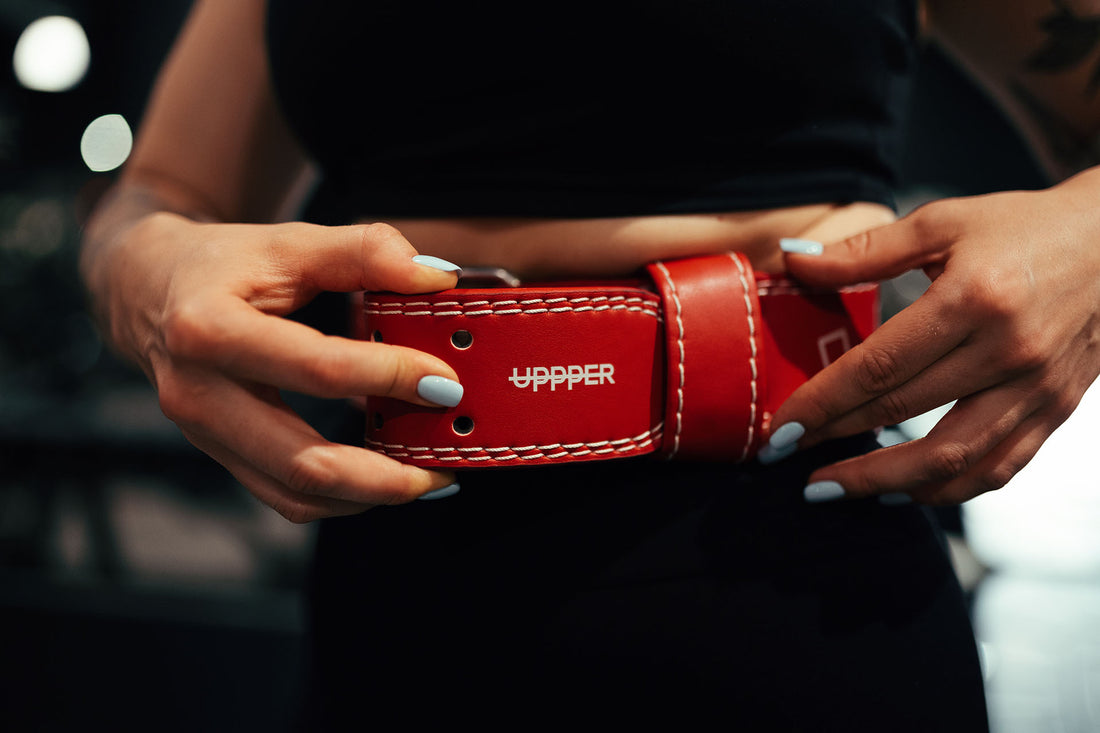In the world of weightlifting, the debate over whether you need a lifting belt for squats is ongoing. Some swear by its benefits, while others argue that it's unnecessary or even detrimental. At UPPPER, we swear by its benefits – we actually carry one of the best lifting belts for squats!
However, for anyone unsure whether lifting belts are for them, we'll be breaking down the benefits of wearing a belt for squats so you can figure out whether you'll add it to your gym bag... or not.
What Is A Lifting Belt?
For those who need a refresher on what a lifting belt is, it's a belt worn around the waist to help provide support and stability to the lower back and core muscles. It's usually worn during squats, deadlifts, barbell rows, and more.
There are different types of lifting belts, like Lever Belts or Prong Belts. Some are made with genuine leather, while others are made with microfiber leather or nylon. But they all do the same thing, support and stabilize your lower back and core.
Benefits Of Wearing A Belt For Squats
Below are four of the top benefits of wearing a weight lifting belt for squats:
Increased Intra-Abdominal Pressure
Using a lifting belt properly will increase intra-abdominal pressure which leads to core stability while also providing your spine optimal support. This can help you lift heavier loads without worrying about your lower back.
Intra-abdominal pressure is how well someone can tighten their core during a squat to maintain good posture and positioning. It's also called "bracing" and it can be done without a belt. A squat belt helps provide a rigid surface to push and brace against which can also help lifters learn how to squeeze their core properly.
Better Muscle Activation In Your Legs And Core
Several studies examined muscle activation while squatting with a belt and have shown that it helps boost the activity of the muscles in the lower back and core during squats. So, despite what many may think, wearing a belt doesn't make your core weak. Because you're core is activated as intra-abdominal pressure increases!
Studies also found better quad muscle activation through the sticking point, and greater hamstring muscle activation as the set progresses. So, wearing a weight lifting belt for squats will help ensure that all the muscles you are targeting are fired up!
Enhanced Training Performance
Increased intra-abdominal pressure and better muscle activation all lead to enhanced training performance! Many lifters find that wearing a lifting belt allows them to lift heavier weights or perform more reps with better form. The added support can boost confidence and stability, leading to improved squat performance.
Reduced Risk of Injury
When used correctly, a lifting belt can reduce the risk of certain injuries, especially in experienced lifters who are pushing their limits with heavy weights. It can provide a buffer against excessive spinal flexion and shear forces.
Who Should Wear A Belt For Squats?
Anyone who wants to go heavier on their squats!
It doesn't matter whether you compete in a sport or not, wearing a weight lifting belt will help you perform the movement safely while also giving you the support you need to push through more reps.
How To Wear A Lifting Belt For Squats
If you've decided you're ready to take your squats to the next level with a weightlifting belt, we'll be showing you how to properly secure it and start using it.
Find the right placement
Generally, the belt should be placed at the bottom of your ribcage, covering your belly button. However, this also depends on your technique or anyone competing! Some may find it more comfortable a few inches up or down, so use that as a guidance and adjust it when it feels comfortable for you.
Once you find the right placement, test it by doing a few bodyweight squats with it. If you're not getting as deep as you'd want or are feeling any pinching or pain then adjust it until it's comfortable.
Find optimal tightness
You want the belt to be tight and secure, but not too tight. There should be enough room for you to breathe and brace properly. A good guidance is to fit a finger between the belt and your stomach, if you're unable to then it's too tight.
Where To Find The Best Lifting Belts For Squats
For high-quality weight lifting belts, UPPPER is the top choice!
Our Prong Lifting Belts and our Lever Belts are best-sellers and highly rated for a good reason.
Our Lifting Belts are made from quality microfiber leather resistant to any abrasions, feature a tapered design ideal for deep squats, and secure with a double-prong belt.
Our 10MM Lever Belts feature two layers of genuine layer for rigid yet flexible support and a lever belt to easily lock in stability – oh, and they're USPA Recommended!
UPPPER Belts have everything you’re looking for to take your squats to the next level.
>> SHOP UPPPER <<


